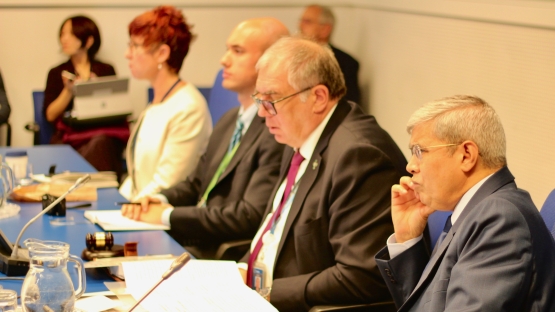When it comes to managing spent fuel from research reactors, countries can choose from several options, such as reprocessing or final disposal in an underground repository. But how do they determine the management strategy that is right for them? Decision tools can help Member States select a strategy; some of these tools were the focus of an event on the sidelines of the IAEA’s 63rd General Conference today.
Research reactors play a vital role around the world in producing neutrons to use for material, medicine, industrial, and agriculture research. They are also utilized for nuclear technology development, education and training. More than 800 research reactors have been built, of which 250 are in operation, and for most of these the spent fuel disposition has yet to be determined.
“This event provided an opportunity to not only review the options available for the management of spent fuel from research reactors, but also to demonstrate how Member States can determine which disposition option is most suitable for them at a given time,” said Frances Marshall, an IAEA research reactor fuel cycle expert. “It can be a difficult decision to make, but through careful analysis the preferred option can become clear.”
Each research reactor should have a spent fuel management plan. The selection and establishment of a suitable plan depends on several factors such as spent fuel volume and content, resource needs and technical capacity, so devising a plan can be a complex process.
Developed as part of the IAEA coordinated research project (CRP) Options and Technologies for Managing the Back End of the Research Reactor Nuclear Fuel Cycle, two Excel-based tools can help stakeholders choose from among the available options. These tools examine factors such as cost, environmental impact, and human resources.
One of the tools, Back End Research Reactor Integrated Decision Making Evaluation (BRIDE), allows for a comparative analysis of the different options based on input from stakeholders, including regulators, government representatives, and research reactor managers. The exercise involves the stakeholders assigning numerical weights to various factors, both cost and non-economic, according to their relative impact on the final decision. Assigned values from each stakeholder are averaged and an overall score for each scenario is calculated to help assess the preferred option.
The other tool, Fuel Cycle Cost Estimation for Research Reactors in Excel (FERREX), can be used to develop detailed cost estimates for spent fuel management options. Attributes such as variable labour rates and the duration of the project are considered, along with spent fuel inventory data to produce a robust cost estimate. FERREX can be used in conjunction with BRIDE or on its own.
Peter Bennett, a researcher at the Institute for Energy Technology in Norway who participated in the CRP, said that the numerical analysis of options enabled by the tools could complement a qualitative analysis. “We have evaluated the options for the management of spent fuel from our research reactors by comparing previously utilized options,” he said. “The quantitative analysis facilitated by the BRIDE and FERREX tools could be very effective in complementing such evaluations and helping a country find the right option for them.”
Mary Lou Dunzik-Gougar, President-Elect of the American Nuclear Society, said that the preferred spent fuel management option can also vary from reactor to reactor due to factors such as reactor size. “The preferred option will not be the same for all research reactors, and so it’s important to approach the decision making process according to a graded approach,” she said. “These tools can bolster such an approach and help a decision be made.”
The attendees participated in an interactive exercise as part of a demonstration of the BRIDE tool. They were asked to assign a value from 1 to 10 to the impact of various factors on a country’s decision regarding research reactor spent fuel management. These values were averaged and input into BRIDE, which then indicated what the preferred option could be.
Kate Roughan, an IAEA disused sealed radioactive sources (DSRS) expert, described how the approach of BRIDE was used to develop a tool to help countries decide on DSRS management options. The flexible nature of this tool in terms of the specific factors included in the evaluation, which can be adjusted by users, makes it suitable to support decisions related to the disposal of DSRS.
“The BRIDE and FERREX tools are meant to help countries make informed choices about spent fuel management based on input from a diverse group of stakeholders,” said Marshall. “It is important for the involved stakeholders to understand the full range of benefits and implications for each option so that the right decision can be made.”
The BRIDE and FERREX tools will soon be available for use by interested Member States.





